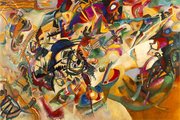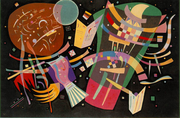Wassily Kandinsky
|
|
Kandinsky_white.jpg
Wassily Kandinsky (Russian: Василий Кандинский, first name sometimes spelled as "Vasily," "Vassily" or "Vasilii") (December 4, 1866 – December 13, 1944) was a Russian-born painter and art theorist. One of the most important 20th-century artists, alongside Picasso and Matisse, he is credited with painting the first abstract works in the history of modern art.
Kandinsky was born in Moscow but spent his childhood in Odessa. He enrolled at the University of Moscow and chose law and economics. Although quite successful in his profession, he started painting studies (life-drawing, sketching and anatomy) at the age of 30. He settled in Munich but went back to Moscow in 1918 after the Russian Revolution. Being in conflict with official theories on art, he returned to Germany in 1921. There he was a teacher at the Bauhaus from 1922 until it was closed by the Nazis in 1933. At that time he moved to France. He lived the rest of his life there, becoming a French citizen in 1939. He died at Neuilly-sur-Seine in 1944.
| Contents |
Artistic periods
Wassily_Kandinsky_-_Munich-Schwabing_with_the_Church_of_St._Ursula.jpg
Kandinsky's development of purely abstract work did not arrive as an abrupt change.
Artistic scholar Hajo Duechting has divided Kandinsky's artistic development into six periods:
- Beginnings (Moscow 1866–1896)
- Metamorphosis (Munich 1896–1911)
- Breakthrough to the Abstract (The Blue Rider 1911–1914)
- Russian Intermezzo (1914–1921)
- Point and Line to Plane (The Bauhaus 1922–1933)
- Biomorphic Abstraction (Paris 1934–1944)
Kandinsky biographer Messer divides his art into three periods:
- Early Period: approximately 1900 to 1914
- Middle Period: from the early 1920s until the early 1930s
- Late Period: from the 1930s until 1944.
Youth and inspirations
Kandinsky's youth and life in Moscow brought inspiration from a variety of sources. As a child he would later recall being fascinated and unusually stimulated with color. This is probably due to his synaesthesia which allowed him to quite literally hear as well as see color. The fascination with color continued as he grew up in Moscow, although he seems to have made no attempt to study art. In 1889 he was part of an ethnographic group that traveled to the Vologda region north of Moscow. His study of the folk art in the region, in particular the use of bright colors on a dark background was reflected in his early work. Kandinsky would write a few years later that 'Color is the keyboard, the eyes are the hammers, the soul is the piano with the strings'.
It was not until 1896, at the age of 30, Kandinsky gave up a promising career teaching law and economics to enroll in art school in Munich. Also in 1896, prior to leaving Moscow, he saw an exhibit of Monet and was particularly taken with a depiction of a haystack which, to him, had a powerful sense of color almost independent of the object itself.
The Blue Rider
Kandinsky's time at art school was helped by the fact that he was older and more settled than the other students and he began to emerge as a true art theorist in addition to being a painter. Unfortunately very little exists of his work from this period, though presumably it was extensive. This changes at the beginning of the 19th Century and much remains of the many landscapes and towns that he painted, using broad swathes of color but recognizable forms. For the most part, however, Kandinsky's paintings did not emphasize any human figures. An exception is Sunday, Old Russia (1904) where Kandinsky recreates a highly colorful (and no doubt fanciful) view of peasants and nobles before the walls of a town. Riding Couple (1907) depicts a man on horseback, holding a woman with tenderness and care as they ride past a Russian town across a river. Yet the horse is muted, while the leaves in the trees, the town, and the reflections in the river glisten with spots of color and brightness.
Perhaps the most important of Kandinsky's paintings from the decade of the 1900s was The Blue Rider (1903) which shows a small cloaked figure on a speeding horse rushing through a rocky meadow. The rider's cloak is a medium view, and the shadow cast is a darker blue. In the foreground are more amorphous blue shadows, presumably the counterparts of the fall trees in the background. The Blue Rider in the painting is prominent, but not clearly defined, and the horse has an unnatural gait (which Kandinsky must have known). Indeed, some believe that a second figure, a child perhaps, is being held by the rider though this could just as easily be another shadow from a solitary rider. Kandinsky shows the rider more as a series of colors than of specific details. In and of itself The Blue Rider is not exceptional in that regard when compared to contemporary painters, but it does show the direction that Kandinsky would take only a few years later.
From 1906 to 1908 Kandinsky spent a great deal of time travelling across Europe, until he came to live in the small bavarian town of Murnau. The Blue Mountain (1908 – 1909) painted at this time shows more of his trend towards pure abstraction. A mountain of blue is flanked by two broad trees, one yellow, and one red. A procession of some sort with three riders and several others crosses at the bottom. The face, clothing, and saddles of the riders are each of a single color, and neither they or the walking figures display any real detail. The broad use of color in The Blue Mountain, illustrate Kandinsky's move towards art in which the color itself is presented independently of form.
Art theories
In addition to painting Kandinsky developed his voice as an art theorist. He helped to found the Munich New Artists' Association in and became its president in 1909. The group was unable to integrate the more radical approach of those like Kandinsky with more conventional ideas of art and the group dissolved in late 1911. Kandinsky then moved to form a new group The Blue Rider (Der Blaue Reiter) with like minded artists such as Franz Marc. The group released an almanac, also called The Blue Rider and held two exhibits. More of each were planned, but the outbreak of World War I in 1914 ended these plans and sent Kandinsky home to Russia via Switzerland and Sweden.
Kandinsky's writing in The Blue Rider Almanac and the treatise On the Spiritual In Art, which was released at almost the same time, served as both a defense and promotion of abstract art, as well as an appraisal that all forms of art were equally capable of reaching a level of spirituality. He believed that color could be used in a painting as something autonomous and apart from a visual description of an object or other form.
Assessment
Along with Piet Mondriaan and Kazimir Malevich, Kandinsky is considered a pioneer in abstract art, undoubtedly the most famous. He was a synaesthete who could, quite literally, hear colors. This effect of color was a major influence on his art, and he even named some of his paintings "improvisations" and "compositions" as if they were works of music and not painting. Works by Kandinsky have been recently sold for as much as US$25 million. Probably the largest collection of his paintings may be seen in the Centre Georges Pompidou, Paris.
See also
References
- The Avant-Garde in Russia by Duechting, Hajo and O'Neill
- Vasily Kandinsky by Thomas M. Messer
External links
- License to practice Kandinsky`s sound or "form-follows-function": Materialize it (http://www.transordinator.de/make%20material/material.html)
- Wassily Kandinsky at Olga's Gallery (http://www.abcgallery.com/K/kandinsky/kandinsky.html)de:Wassily Kandinsky
es:Wasily Kandinsky fr:Wassily Kandinsky it:Vasily Kandinsky he:ואסילי קנדינסקי nl:Wassili Kandinski ja:ワシリー・カンディンスキー pt:Wassily Kandinsky sv:Wassily Kandinsky zh:瓦西里·康定斯基


